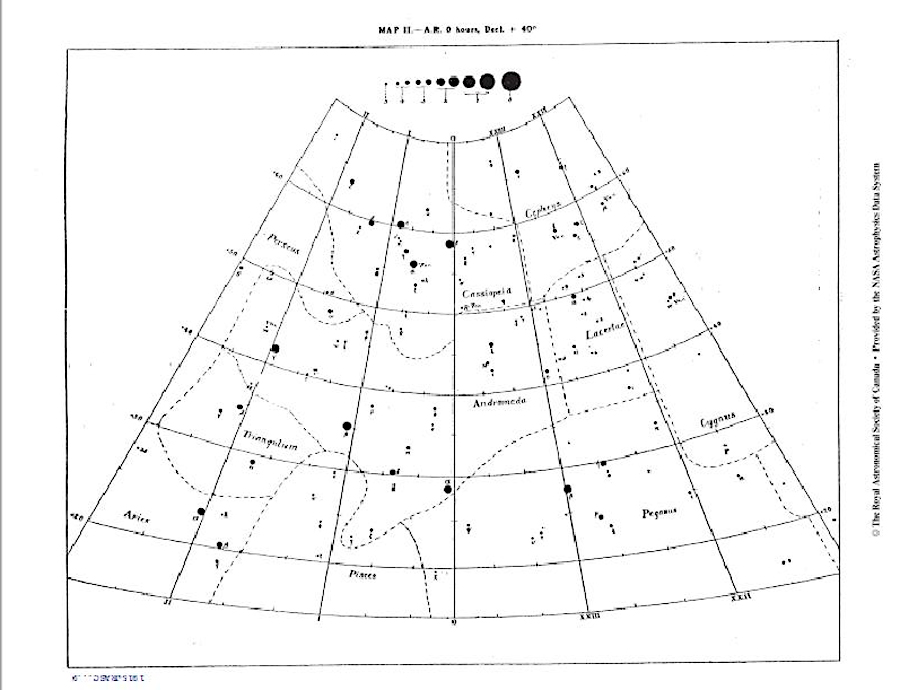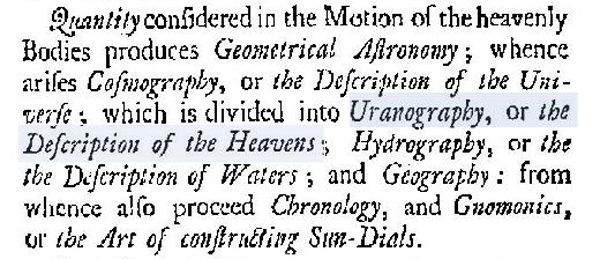
Plate II from R.K. Young's Gnomonic Star Atlas (JRASC 1915)
It is interesting to compare the star atlasses avaiable to amateurs in the early days of the RASC to those used by amateurs today. One of the most obvious differences is in the media used; while the traditional medium of print is still viable, various star atlasses are now avaiable in a variety of electronic formats. Most (but not all) are now computer generated, and it seems that even those constructed with a naked-eye limiting magnitude show more deep-sky objects than did those of the past. The constellation boundaries are different (current atlasses use the IAU established boundaries of 1930). And some atlasses in amateur hands in the second half of the 19th century still used the classical constellation figures, which are no longer a feature of any modern atlas. The simularities, however, probably outwegh the differences. And the older atlasses can still be used today, if one wants to expereince somehting of the flavour of older styles of observing.
______________________________________
"Uranography" is a word of unusual occurrence today, but it has some currency in the consciousness of amateurs who enjoy celestial cartography through its use by Wil Tirion to describe what he does. The word uranographia (1572) is post-classical, and also appeared in Western Euopean sources of the 17th-19h centuries with a more Greek looking othrography as ouranographia, Englished as ouranography. Neither form is particularly frequent in the Enlightenment, and the word could have theological and astrological meanings as well. There is a marked precicosity in its present use.
The Plan of the French Encyclopedia, or Universal Dictionary...
Translated from the Preface of the French Editors Mess. Diderot and Alembert
(London: W. Innys et al., 1752), p. 165
______________________________________
Authoritative secondary sources worth consulting on the history of on celestial mapping are:
- Elly Dekker, Illustrating the Phaenomena: Celestial Cartography in Antiquity and the Middle Ages (Oxford: Oxford University Press, 2012)
- Deborah J. Warner, The Sky Explored: Celestial Cartography, 1500-1800 (New York : A. R. Liss, 1979)
- The History of Cartography series, published by the University of Chicago Press (many of the volumes can be freely consulted online)
The Linda Hall Library has an excellent colleciton of historical celestial atlasses, and has been very public- spirited in providing online access to electronic facsimiles of their holdings.Several useful introductions to the institiution's celestial atlasses have been written by William Ashworth
Other treatments are:
- Nick Kanas, Star Maps: History, Artistry, and Cartography, 2nd ed. (New York–Heidelberg–Dordrecht–London: Springer, 2012)
- John C. Barentine, The Lost Constellations: A History of Obsolete, Extinct, or Forgotten Star Lore (Cham–Heidelberg–New York–Dordrecht–London: Springer, 2016)—relies on out-dated and unrelible sources; must be used with caution
- John C. Barentine, Uncharted Constellations: Asterisms, Single-Source and Rebrands (Cham Heidelberg New York Dordrecht London: Springer, 2016)—relies on out-dated and unrelible sources; must be used with caution
Prof. Gurshtein has recently published a monograph setting out his views on the origin of the greco-Roman tradition of the constellations: Alex A. Gurshtein, The Puzzle of the Western Zodiac: Its Wisdom and Evolutionary Leaps: A Painful Ascent to the Truth (Bloomington IN: AuthorHouse, 2017). For a criticism of his approach, see Gary D. Thompson's analysis.
Ptolemy's Almagest is avaible in an accurate and conveninet translation by Gerald Toomer: Ptolemy's Almagest, tr. & ed. G.J. Toomer (London: Duckworth, 1984).
Alexnader Jamieson and his atlas are discussed by Ian Ridpath, "Alexander Jamieson, Celestial Map Maker", Astronomy & Geophysics 54, 1, (2013 February), 1.22–1.23, on Felice Stoppa's site, Atlas Coelestis.
John Hill's URANIA: or, a Compleat VIEW of the HEAVENS, containing the ANTIENT and MODERN ASTRONOMY, In Form of a DICTIONARY... (London: T. Gardner, 1754) can be found here.
The experimentation to find the best solution to naked-eye star charts in the RASC Observer's Handbook can be traced through these editions:
- The Canadian Astronomical Handbook for 1907, ed. C.A. Chant (Toronto: Royal Astronomical Society of Canada, 1906), pp. 78-100—the inaugural solution
- The Observer's Handbook for 1912, ed. C.A. Chant (Toronto: Royal Astronomical Society of Canada, 1912), pp. 55-64—mag. 4 atlas
- The Observer's Handbook for 1915, ed. C.A. Chant (Toronto: Royal Astronomical Society of Canada, 1915), unpaginated charts at end of book—R.K. Young's seasonal star charts
The Society published R.K. Young 's mag. 5 atlas the same year his charts were used in the Observer's Handbook: Reynold K. Young, "A Gnomic Star Atlas", JRASC 9, 1 (1915 January), 7-10 (charts bewteen pp. 14-15).
Damien Lemay's award winning Atlas Photographique (1982) can be viewed online, along with his illuminating technical notes.
The Rev’d Dr. Robert Evans extragalactic supernovae discoveries have been the subject of several articles (e.g., Edwin L. Aguirre, Supernova Champ Makes 40th Find, September 6, 2005), which all duly mention his use of mental star maps.
—R.A. Rosenfeld
A transcript of this podcast is available.
| Attachment | Size |
|---|---|
| 190.62 KB | |
| 4.45 MB |

